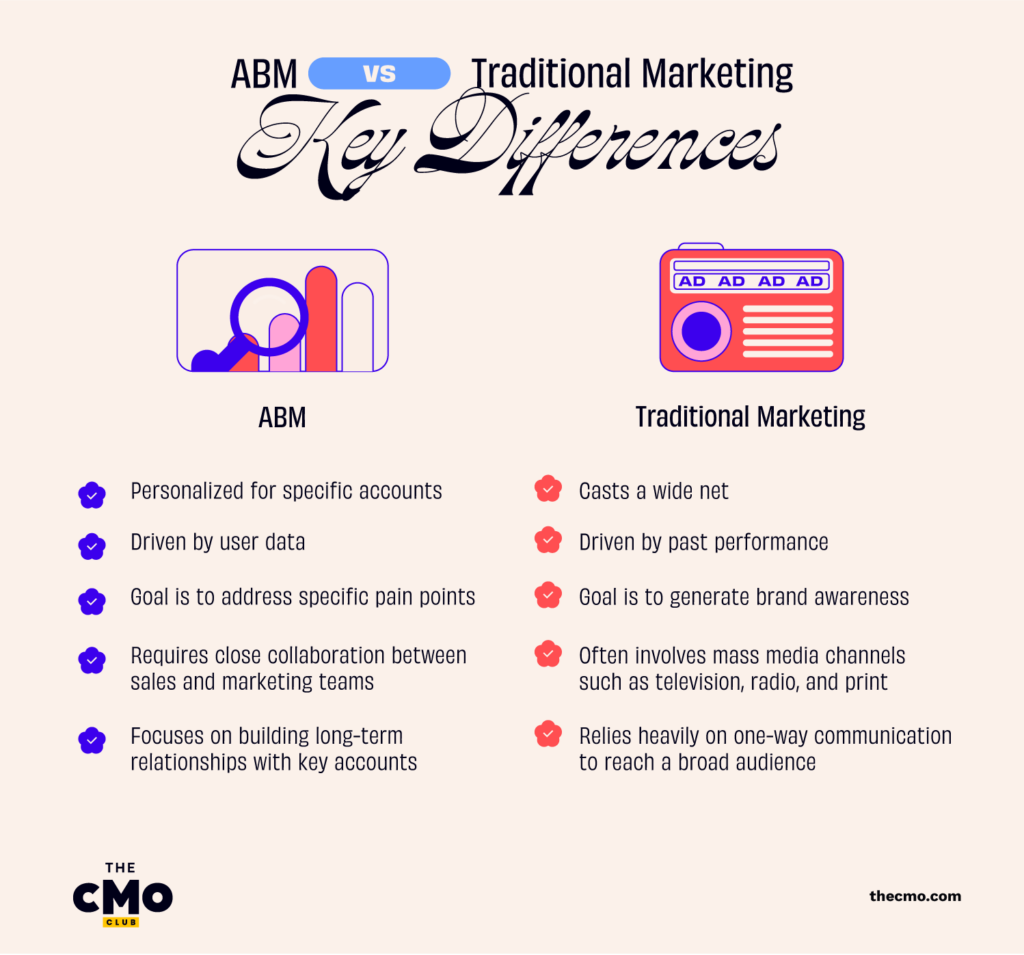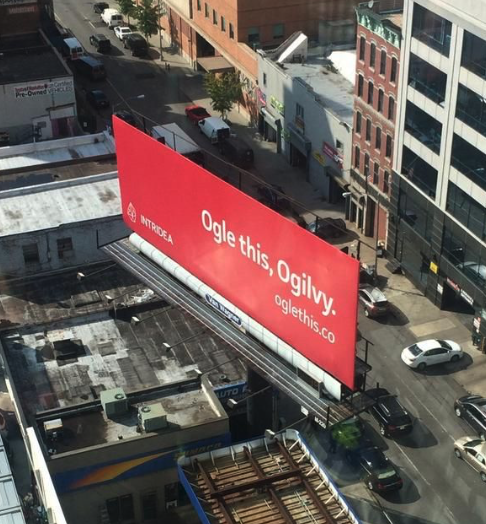You don’t make it past day one as a marketer without being introduced to the concept of “the funnel,” AKA the upside-down pyramid that represents the various stages of the customer journey according to traditional marketing.
But what about an approach that takes that conventional funnel and flips it on its head—literally? Enter account-based marketing. ABM requires a narrowed focus for higher impact and, oftentimes, better results. Combined with the use of ABM software, businesses have seen many benefits from employing an ABM strategy, from greater efficiency to a higher ROI.
Before abandoning your current strategy—and consigning your latest marketing assets to the recycle bin—you should know how the advantages of abm stratgies, and how it differs from traditional marketing. With this knowledge, you’ll be well equipped to determine whether this approach aligns with your own business needs.
ABM vs Traditional Marketing: Key Differences
Traditional marketing takes a broader approach to lead generation, with the goal being to capture as many leads as possible. Account-based marketing, on the other hand, prioritizes marketing to a more precise audience.
ABM is typically thought of as inverting the typical B2B lead gen funnel. Instead of marketing to a broad audience and narrowing down prospects as they move through the stages, the ABM funnel starts by identifying target accounts, designing personalized campaigns, and choosing distribution channels where you know that client spends time. This highly targeted approach aims to delight high-value prospects to the point that they convert into customers.

What Is Account-Based Marketing?
To dig into this side of the comparison a bit more, account-based marketing is a strategy that prioritizes high-value accounts in an attempt to enhance customer acquisition. ABM works by creating a highly personalized customer experience that fosters relationship-building and drives business expansion.
Examples Of Account-Based Marketing
Personalized large-scale billboard campaign by Invidea
One of the boldest examples of ABM I've seen is Invidea’s billboard campaign.
The web product and services company installed a billboard across the street from their target client—in this case, global advertising agency Ogilvy & Mather—with the simple statement “Ogle this, Ogilvy.” Invidea successfully identified their ideal client and came up with a marketing concept that speaks to them directly (and reaches them where they spend most of their time).

Personalized swag (bobbleheads) for Dreamforce by Engagio
B2B marketing engagement software company Engagio was looking to expand its market reach. After determining their ideal companies to work with, they noticed that many of these prospects had something in common—they were all attendees of Salesforce’s annual conference, Dreamforce.
With this in mind, Engagio decided to take a rather unconventional approach—they showed up at the conference with bobblehead versions of each company’s directors. They sent each company an email with photos of the bobbleheads, directing them to Engagio’s booth for pickup.
This unconventional approach certainly set them apart from their competitors, infused some humor into the process, and got them a foot in the door with key decision-makers at their dream companies.

Advantages Of Account-Based Marketing
This strategy works for B2B businesses whose products or services are targeting enterprise-level clientele, and have the price tag to match.
- Data-driven: Creating an ABM campaign requires getting into the nitty-gritty and knowing your numbers, but it also gives you the power to closely track the performance of your campaigns on an individual account level and make adjustments as needed.
- Appeals to multiple key decision-makers: According to Harvard Business Review, an average 5.4 people are involved in the B2B buying process, challenging marketers to create campaigns that speak to each stakeholder. ABM allows you to implement highly personalized marketing campaigns and demonstrate a clear understanding of your clients and their pain points.
- Fosters collaboration between sales and marketing: Sales teams and marketing teams can sometimes be at odds, even when their overarching goals are the same. ABM encourages your sales and marketing teams to work together to identify key prospects, design targeted marketing campaigns, and optimize your sales process.
When To Use An ABM Strategy
Account-Based Marketing (ABM) strategies are particularly well-suited for B2B companies operating within lengthy, intricate sales cycles, frequently involving numerous stakeholders and carrying substantial value.
A great example of this is Personify. The company wanted to invest heavily in marketing, but they had limited budget and virtually no online presence.
Demand generation manager Amber Whatley proposed implementing an ABM strategy in order to kickstart the brand’s digital marketing efforts and establish their authority. Traditional marketing efforts had failed to produce the desired results and Amber realized she was better off creating highly personalized marketing materials that would have a bigger impact on their target audience.
She started by defining an ideal customer profile. From there, she took a personalized one to one marketing approach, designing marketing materials for each buyer according to their needs and desires.
The results?
- 39x lift in engaged site visitors
- 47x ROI on contributed pipeline
- 25x ROI on contributed revenue
- 8.5x ROI on marketing-sourced revenue
Holy ROI! This is just one example of how ABM can transform your business’s marketing strategy, boost conversion rates, and revive your marketing efforts.
What Is Traditional Marketing?
On the flip side of the comparison, traditional marketing is an approach that aims to attract the attention of a large audience of potential customers, the idea being to continue to educate and entice them through continued marketing efforts until they become your ideal prospect and convert.
Examples Of Traditional Marketing
Coca-Cola's "Share a Coke" campaign
This unforgettable marketing campaign involved replacing Coca-Cola’s iconic logo with the most popular names in each country where the campaign was introduced. The brand’s personalized strategy delighted viewers who took to social media to share their thoughts, furthering the impact of the campaign.

McDonald’s’ “I’m Lovin’ It” campaign
This iconic marketing campaign successfully captured the hearts of consumers worldwide, and its accompanying five-note jingle became synonymous with the brand. McDonald’s launched this campaign with five commercials in 11 different languages, garnering the brand's international appeal and resonating with fast food aficionados across the globe.

Advantages Of Traditional Marketing
While ABM may be known to deliver high ROI, there are still certain advantages to consider when it comes to a traditional marketing approach.
- Time-efficient: Traditional marketing campaigns can be turned around at a faster rate and typically require less resources to execute effectively.
- Wide-reaching: Traditional marketing methods excel in generating leads by virtue of their broad reach. They cast a wide net to capture a broad audience, prioritizing breadth over specificity and segmentation in targeting.
When To Use A Traditional Marketing Strategy
While ABM campaigns boast some impressive metrics, we can’t be so quick to rule out traditional marketing strategy altogether.
In an attempt to reach a wider audience, Microsoft adopted a B2C-style marketing approach, appealing to the pain points of their new target market—individual consumers working from home.
The brand’s strategic approach included leveraging various marketing channels, including social media marketing, to reach its target audience of new users while also crafting its marketing messages to appeal to existing customers.
The content empathized with the challenges and triumphs of hybrid work, emphasizing the empowerment of users and the importance of maintaining a work-life balance. This approach encompassed creative feature posts, emotionally engaging videos, seasonal content, and conventional B2B materials such as case studies, appearing on platforms from TikTok to LinkedIn.
The result?
- 38% increase in social media followers
- 28% increase in engagement year over year
Due to the brand’s omnichannel marketing approach, it’s more difficult to gauge the overall impact of the campaign on inbound marketing results. However, the brand succeeded in one of the main goals of traditional marketing campaigns: increasing brand awareness.
ABM Vs Traditional Marketing: The Key Takeaways
When it comes to choosing between traditional marketing and ABM, there’s no one-size-fits-all approach. The answer lies in the specific needs and goals of your business. To decide, ask yourself the following questions:
- Who is my product for? Is it a high-cost item for executives that may require multiple decision makers, or affordable and made for the masses?
- Do I have a roster of ideal clients I aspire to engage with?
- Are traditional marketing methods delivering the desired outcomes?
If you’re not having luck employing traditional marketing tactics, it may be time to explore account-based marketing. Of course, I highly encourage you to learn more about it through various ABM events before adopting it as a strategy.
ABM is especially popular with B2B companies who employ this strategy by creating hyper-personalized marketing materials that speak directly to a specific account. Unlike traditional marketing tactics that attempt to appeal to a wide audience, ABM favors a targeted approach for maximum impact.
To learn more different marketing strategies, subscribe to The CMO newsletter and get the latest trends, techniques, and expert tips straight to your inbox.


